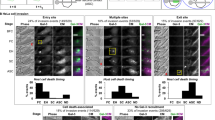Abstract
The rapid-freezing technique was applied in association with scanning and transmission electron microscopy to observe the initial attachment (or contact) ofCandida albicans cells to exfoliated human buccal epithelial cells. Low temperature scanning electron microscopy provided detailed three-dimensional morphological features of the yeast-epithelial cell association; adhesion ofC. albicans cells to host cells was primarily owing to an interaction between fibrillar layer of the yeast cell wall and the membrane interdigitations of the epithelial cells. Such a particular interconnection between the two cells was confirmed by the freeze-substitution fixation for transmission electron microscopy. These results clearly demonstrate the outermost fibrillar cell wall layer ofC. albicans responsible for adhesion to host cells.
Similar content being viewed by others
References
Borg M, Rüchel R. Expression of extracellular acid proteinase by proteolyticCandida spp. during experimental infection of oral mucosa. Infect Immun 1988; 56: 626–31.
Calderone RA, Lehrer N, Segal E. Adherence ofCandida albicans to buccal and vaginal epithelial cells: ultrastructural observations. Can J Microbiol 1984; 30: 1001–7.
Cassone A, Mattia E, Boldrini L. Agglutination of blastospores ofCandida albicans by concanavalin A and its relationship with the distribution of mannan polymers and the ultrastructure of the cell wall. J Gen Microbiol 1978; 105: 263–73.
Critchley IA, Douglas LJ. Isolation and partial characterization of an adhesin fromCandida albicans. J Gen Microbiol 1987; 133: 629–36.
Douglas LJ. Adhesion ofCandida species to epithelial surfaces. CRC Crit Rev Microbiol 1987; 15: 27–43.
Douglas LJ, Houston JG, McCourtie J. Adherence ofCandida albicans to human buccal epithelial cells after growth on different carbon sources. FEMS Microbiol Lett 1981; 12: 241–3.
Handley PS, Hargreaves J, Harty DWS. Ruthenium red staining reveals surface fibrils and a layer external to the cell wall inStreptococcus salivarius HB and adhesion deficient mutants. J Gen Microbiol 1988; 134: 3165–72.
Howlett JA, Squier CA.Candida albicans ultrastructure: colonization and invasion of oral epithelium. Infect Immun 1980; 29: 252–60.
Kennedy MJ. Adhesion and association mechanisms ofCandida albicans. In: McGinnis MR, ed. Current topics in medical mycology, Vol. 2. New York: Springer-Verlag, 1987: 73–169.
Kennedy MJ, Sandin RL. Influence of growth conditions onCandida albicans adhesion, hydrophobicity and cell wall ultrastructure. J Med Vet Mycol 1988; 26: 79–92.
Kimura LH, Pearsall NN. Adherence ofCandida albicans to human buccal epithelial cells. Infect Immun 1978; 21: 64–8.
Makrides HC, MacFarlane TW. Effect of commensal bacteria on the adherence ofCandida albicans to epithelial cellsin vitro. Microbios Lett 1982; 21: 55–61.
Marrie TJ, Costerton JW. The ultrastructure ofCandida albicans infections. Can J Microbiol 1981; 27: 1156–64.
McCourtie J, Douglas LJ. Relationship between cell surface composition ofCandida albicans and adherence to acrylic after growth on different carbon sources. Infect Immun 1981; 32: 1234–41.
McCourtie J, Douglas LJ. Extracellular polymer ofCandida albicans: isolation, analysis and role in adhesion. J Gen Microbiol 1985; 131: 495–503.
Miragall F, Rico H, Sentandreu R. Regeneration of the cell wall in protoplasts ofCandida albicans a cytochemical study using wheat germ agglutinin and concanavalin A. Arch Microbiol 1988; 149: 286–90.
Ray TL, Payne CD. Scanning electron microscopy of epidermal adherence and cavitation in murine candidiasis: a role forCandida acid proteinase. Infect Immun 1988; 56: 1942–9.
Segal E, Lehrer N, Ofek I. Adherence ofCandida albicans to human vaginal epithelial cells: inhibition by amino sugars. Expl Cell Biol 1982; 50: 13–7.
Tokunaga M, Kusamichi M, Koike H. Ultrastructure of outermost layer of cell wall inCandida albicans observed by rapid-freezing technique. J Electron Microsc 1986; 35: 237–46.
Tronchin G, Bouchara J-P, Robert R, Senet J-M. Adherence ofCandida albicans germ tubes to plastic: ultrastructural and molecular studies of fibrillar adhesins. Infect Immun 1988; 56: 1987–93.
Tronchin G, Poulain D, Herbaut J, Biguet J. Cytochemical and ultrastructural studies ofCandida albicans. II. evidence for a cell wall coat using concanavalin A. J Ultrastruct Res 1981; 75: 50–9.
Tronchin G, Poulain D, Vernes A. Cytochemical and ultrastructural studies ofCandida albicans. III. evidence for modifications of the cell wall coat during adherence to human buccal epithelial cells. Arch Microbiol 1984; 139: 221–4.
Author information
Authors and Affiliations
Rights and permissions
About this article
Cite this article
Tokunaga, M., Niimi, M., Kusamichi, M. et al. Initial attachment ofCandida albicans cells to buccal epithelial cells. Mycopathologia 111, 61–66 (1990). https://doi.org/10.1007/BF02277306
Received:
Accepted:
Issue Date:
DOI: https://doi.org/10.1007/BF02277306




